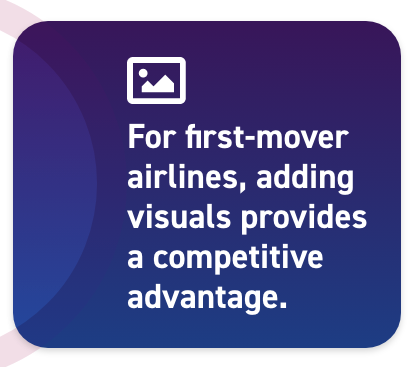
Some retail categories are now largely purchased online, from books and music to fashion retail and technology. Retail data company Profitero recommends an average of 6-8 pictures per item for sale on Walmart.com, and recent ATPCO research shows that flight shoppers want 4-6. While people have come to expect to see multiple pictures of every T-shirt, pair of headphones, and even toothbrushes sold online, airline tickets are another story.
While the average price of a flight is significantly higher than most items purchased online, airlines have not yet fully embraced the concept of visual search, even though consumers want them. In fact, ATPCO’s recent survey of 500 consumers from 30 regions across the globe found one universal truth—83 percent of flight shoppers want visuals of the seat, legroom, and in-flight extras. Not only that, and maybe more surprisingly, one third said they’d pay more if they were able to see what they were getting. ATPCO has the insights that empower your journey toward unlocking the full potential of modern airline retailing.
Flight shoppers want transparency while booking
While the retail world evolved to deliver a more visual online shopping approach, airlines have held onto their text-oriented shopping experience for far too long. While it’s understandable that enabling in-depth comparison shopping across multiple airlines and fare brand products is difficult to visually showcase, there are many innovative ways to highlight a more retail-rich flight shopping experience. There are also likely a few fears that have held airlines back from embracing images and airline merchandising.
First, while certain airlines’ economy legroom has gotten smaller, airlines understandably may not be very excited to advertise that. Second, there’s a lot of complexity. With airline tickets, there’s a level of variation that airlines can’t always predict months into the future, and not all planes have the same experience. The seats and layout configuration might vary, the in-flight entertainment might be configured differently, and charging ports for devices may or may not be available. We understand it’s far easier to merchandise a T-shirt or a book online than it is a flight. You can return a T-shirt that doesn’t look like what you saw online. It’s a lot harder to do the equivalent with an airline ticket.
Despite these hurdles, progress is being made, and airlines and travel sellers should be proud of the leaps forward they have taken, for example KAYAK’s OTA site or Gulf Air’s direct sites. Airlines don’t just need to implement more visuals of the flight experience only to benefit consumers. Airlines and sellers can also benefit by increasing their bottom line. Other prominent studies have found that visual search has the potential to increase airline revenue.

Northwestern University found that visual search is the most trusted by consumers across the board. For first-mover airlines, adding visuals provides a competitive advantage. The reality is that most airlines are working within similar parameters but showing the size of a coach seat with an image, our survey indicates, will actually encourage someone to upgrade more than it pushes them towards another airline entirely (which likely has the same size seats).
Airlines don’t need a brand new A350 to add images to the flight shopping experience and shouldn’t worry that shoppers will judge images too harshly. With the right approach and tools like our Routehappy airline merchandising solution, airlines can give shoppers the visual experience they expect while effectively handling challenging aspects. Visuals can show a range of seats that the consumer might expect to sit in, for example. Research done by ATPCO shows that images actually build more trust with customers in the long run. We found that 70 percent of shoppers would likely upgrade from basic economy to economy if they saw what they were getting.
How ATPCO enables you to create meaningful difference with airline merchandising
As more airlines try to create a competitive edge, visuals can also be used to highlight specific extras that matter to different flight shoppers. Consumers care a lot about in-flight amenities, and they can become a competitive advantage. Our study found that 80 percent of shoppers compare offers from multiple airlines. If someone can actually see the legroom, extra carry-on size, or in-flight meal that they will be getting, research shows that they’ll likely prefer it over an offer they can’t see.
With airlines embracing dynamic offers to deliver more personalized, tailored options for shoppers, consumers are much more likely to select offers that show images. Visuals can provide a sort of turbo boost to increase customer satisfaction. So how can ATPCO help you create these better, more modern, and in-demand airline merchandising experiences?
ATPCO’s Routehappy is the airlines’ solution to enhance how they present and merchandise their flights to travelers. By using Routehappy’s airline merchandising capabilities, airlines can set themselves apart by customizing their offerings and delivering them in a manner that resonates with the expectations of today’s flight shoppers. In today’s market, flight shoppers want a better understanding of their purchase before boarding. You can elevate your airline’s offers through targeted messaging and visual content that provides customers with a top-tier, modern shopping experience.
If you’re ready to start embracing modern airline retailing to meet today’s flight shoppers’ expectations, it’s time to talk with us.
Let's talk airline merchandising
A version of this article first appeared on Travolution on 5 September 2023.


